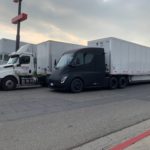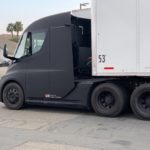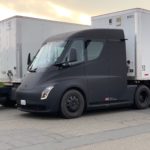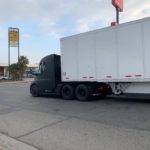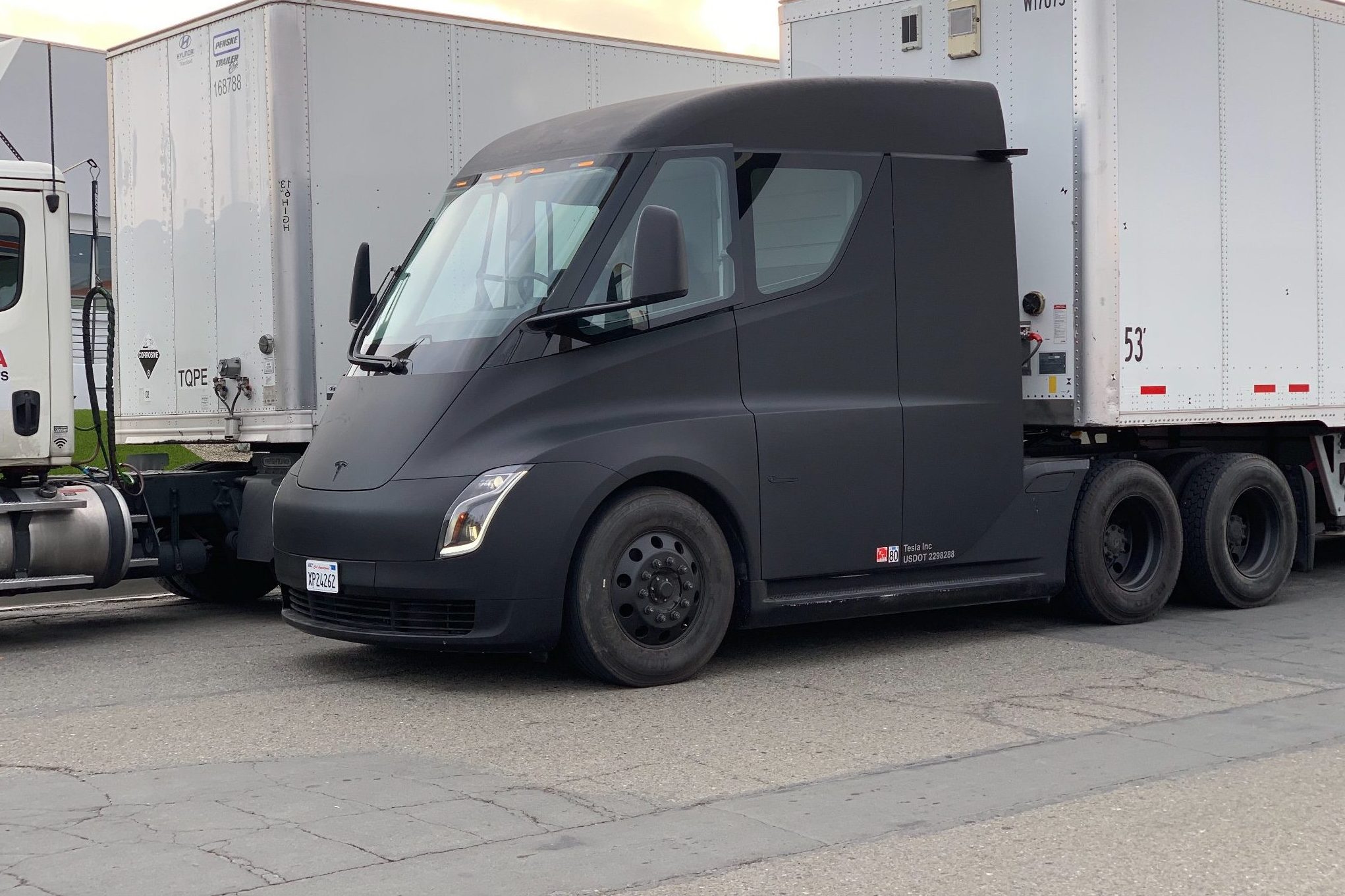
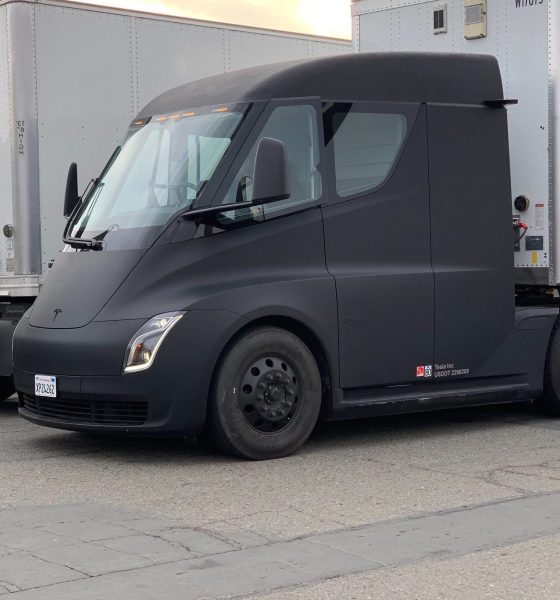
News
Tesla’s matte black Semi prototype makes rare appearance in Kettleman City Supercharger
After staying under the radar for the past few months, Tesla’s matte black Semi prototype has been spotted on US roads once more. This time around, the all-electric long hauler was sighted pulling a trailer at the 40-stall Kettleman City Supercharger, located between San Francisco and Los Angeles.
The matte black Tesla Semi prototype was photographed by Tesla enthusiast James Douma, who noted that he spotted the vehicle on Wednesday afternoon. In a conversation with Teslarati, James stated that the vehicle seemed to be traveling alone, as the truck only had one person inside. Such an observation is quite interesting, considering that the silver Semi test mule traveling across the United States is usually accompanied by a team of engineers.
The Tesla enthusiast also remarked that he was informed by the staff of the Kettleman City Supercharger that it was the first time the matte black Semi prototype visited the location. The silver Semi test mule, on the other hand, has reportedly visited the site on four different occasions. The matte black Semi did not stay very long in the Kettleman site on Wednesday, though, as the vehicle promptly left the location soon after the photos were taken.
- Tesla’s matte black Semi prototype makes a rare appearance at the Kettleman City Supercharger. (Photo: James Douma)
- Tesla’s matte black Semi prototype makes a rare appearance at the Kettleman City Supercharger. (Photo: James Douma)
Tesla’s matte black Semi prototype makes a rare appearance at the Kettleman City Supercharger. (Photo: James Douma)
Sightings of the Tesla Semi during recent months have featured the silver test mule, which has been spotted in multiple states across the US. The matte black Semi, which also made an appearance at the vehicle’s unveiling back in November 2017, was last seen in April as it was being transported on a trailer heading east into I-80 in the Des Moines, IA area, near the headquarters of Ruan Transportation Management Systems, a reservation holder for the all-electric truck.
Prior to that, the matte black Semi was sighted a couple of times with its silver sibling, as the vehicles transported cargo between Tesla’s Fremont factory and Gigafactory 1 in Nevada. The last sighting of the matte black truck traveling alone was back in January, when it was filmed driving down a street in Sunnyvale, CA. While the electric car maker has not provided a reason behind the vehicle’s absence during the past few months, it is nonetheless refreshing to the see sleek prototype back on the roads once more.
- Tesla’s matte black Semi prototype makes a rare appearance at the Kettleman City Supercharger. (Photo: James Douma)
- Tesla’s matte black Semi prototype makes a rare appearance at the Kettleman City Supercharger. (Photo: James Douma)
- Tesla’s matte black Semi prototype makes a rare appearance at the Kettleman City Supercharger. (Photo: James Douma)
Tesla’s matte black Semi prototype makes a rare appearance at the Kettleman City Supercharger. (Photo: James Douma)
The Tesla Semi has the potential to be the company’s most disruptive vehicle to date. Being designed to compete in the highly-competitive trucking industry, the Semi is equipped with several features that make it a viable and preferable alternative to diesel-powered vehicles. The Semi is propelled by four Model 3-derived electric motors that provide instant torque, allowing the Semi to go from 0-60 mph in 5 seconds flat without a trailer. The vehicle was also announced with a range of either 300 miles or 500 miles per charge, though Elon Musk later noted that truck’s long-range variant would have closer to 600 miles of range per charge.
The Tesla Semi is set to be supported by a network of Megachargers, which would be capable of replenishing 400 miles of range in as little as 30 minutes of charging. Unlike the Supercharger Network, which has a power output of roughly 120 kW, speculations are high that Tesla’s Megacharger will see around ten times the power levels. As Tesla conducts road tests of the Semi, though, the company has been adopting a temporary charging solution for the vehicle, using a series of Supercharger stalls connected to a hub, which is, in turn, connected to the all-electric truck.

News
Tesla FSD fleet is nearing 7 billion total miles, including 2.5 billion city miles
As can be seen on Tesla’s official FSD webpage, vehicles equipped with the system have now navigated over 6.99 billion miles.

Tesla’s Full Self-Driving (Supervised) fleet is closing in on almost 7 billion total miles driven, as per data posted by the company on its official FSD webpage.
These figures hint at the massive scale of data fueling Tesla’s rapid FSD improvements, which have been quite notable as of late.
FSD mileage milestones
As can be seen on Tesla’s official FSD webpage, vehicles equipped with the system have now navigated over 6.99 billion miles. Tesla owner and avid FSD tester Whole Mars Catalog also shared a screenshot indicating that from the nearly 7 billion miles traveled by the FSD fleet, more than 2.5 billion miles were driven inside cities.
City miles are particularly valuable for complex urban scenarios like unprotected turns, pedestrian interactions, and traffic lights. This is also the difference-maker for FSD, as only complex solutions, such as Waymo’s self-driving taxis, operate similarly on inner-city streets. And even then, incidents such as the San Francisco blackouts have proven challenging for sensor-rich vehicles like Waymos.
Tesla’s data edge
Tesla has a number of advantages in the autonomous vehicle sector, one of which is the size of its fleet and the number of vehicles training FSD on real-world roads. Tesla’s nearly 7 billion FSD miles then allow the company to roll out updates that make its vehicles behave like they are being driven by experienced drivers, even if they are operating on their own.
So notable are Tesla’s improvements to FSD that NVIDIA Director of Robotics Jim Fan, after experiencing FSD v14, noted that the system is the first AI that passes what he described as a “Physical Turing Test.”
“Despite knowing exactly how robot learning works, I still find it magical watching the steering wheel turn by itself. First it feels surreal, next it becomes routine. Then, like the smartphone, taking it away actively hurts. This is how humanity gets rewired and glued to god-like technologies,” Fan wrote in a post on X.
News
Tesla starts showing how FSD will change lives in Europe
Local officials tested the system on narrow country roads and were impressed by FSD’s smooth, human-like driving, with some calling the service a game-changer for everyday life in areas that are far from urban centers.

Tesla has launched Europe’s first public shuttle service using Full Self-Driving (Supervised) in the rural Eifelkreis Bitburg-Prüm region of Germany, demonstrating how the technology can restore independence and mobility for people who struggle with limited transport options.
Local officials tested the system on narrow country roads and were impressed by FSD’s smooth, human-like driving, with some calling the service a game-changer for everyday life in areas that are far from urban centers.
Officials see real impact on rural residents
Arzfeld Mayor Johannes Kuhl and District Administrator Andreas Kruppert personally tested the Tesla shuttle service. This allowed them to see just how well FSD navigated winding lanes and rural roads confidently. Kruppert said, “Autonomous driving sounds like science fiction to many, but we simply see here that it works totally well in rural regions too.” Kuhl, for his part, also noted that FSD “feels like a very experienced driver.”
The pilot complements the area’s “Citizen Bus” program, which provides on-demand rides for elderly residents who can no longer drive themselves. Tesla Europe shared a video of a demonstration of the service, highlighting how FSD gives people their freedom back, even in places where public transport is not as prevalent.
What the Ministry for Economic Affairs and Transport says
Rhineland-Palatinate’s Minister Daniela Schmitt supported the project, praising the collaboration that made this “first of its kind in Europe” possible. As per the ministry, the rural rollout for the service shows FSD’s potential beyond major cities, and it delivers tangible benefits like grocery runs, doctor visits, and social connections for isolated residents.
“Reliable and flexible mobility is especially vital in rural areas. With the launch of a shuttle service using self-driving vehicles (FSD supervised) by Tesla in the Eifelkreis Bitburg-Prüm, an innovative pilot project is now getting underway that complements local community bus services. It is the first project of its kind in Europe.
“The result is a real gain for rural mobility: greater accessibility, more flexibility and tangible benefits for everyday life. A strong signal for innovation, cooperation and future-oriented mobility beyond urban centers,” the ministry wrote in a LinkedIn post.
News
Tesla China quietly posts Robotaxi-related job listing
Tesla China is currently seeking a Low Voltage Electrical Engineer to work on circuit board design for the company’s autonomous vehicles.

Tesla has posted a new job listing in Shanghai explicitly tied to its Robotaxi program, fueling speculation that the company is preparing to launch its dedicated autonomous ride-hailing service in China.
As noted in the listing, Tesla China is currently seeking a Low Voltage Electrical Engineer to work on circuit board design for the company’s autonomous vehicles.
Robotaxi-specific role
The listing, which was shared on social media platform X by industry watcher @tslaming, suggested that Tesla China is looking to fill the role urgently. The job listing itself specifically mentions that the person hired for the role will be working on the Low Voltage Hardware team, which would design the circuit boards that would serve as the nervous system of the Robotaxi.
Key tasks for the role, as indicated in the job listing, include collaboration with PCB layout, firmware, mechanical, program management, and validation teams, among other responsibilities. The role is based in Shanghai.
China Robotaxi launch
China represents a massive potential market for robotaxis, with its dense urban centers and supportive policies in select cities. Tesla has limited permission to roll out FSD in the country, though despite this, its vehicles have been hailed as among the best in the market when it comes to autonomous features. So far, at least, it appears that China supports Tesla’s FSD and Robotaxi rollout.
This was hinted at in November, when Tesla brought the Cybercab to the 8th China International Import Expo (CIIE) in Shanghai, marking the first time that the autonomous two-seater was brought to the Asia-Pacific region. The vehicle, despite not having a release date in China, received a significant amount of interest among the event’s attendees.
